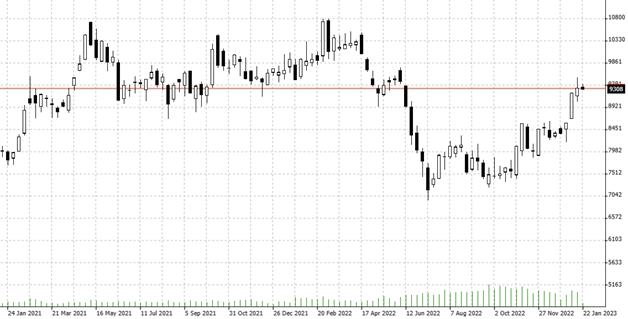

24.01.2023 – The bulls are on the attack: according to many experts, the price of the red metal will rise sharply. For one thing, China is back. For another, electrification in the planned energy turnaround can only be achieved with copper. But the resources are obviously not enough.
After a setback from the all-time high, which was triggered by recession fears, copper may now be starting a new bull run – here is the weekly chart. In any case, the copper price has risen strongly due to the opening of the Chinese market after the Corona pandemic.

Source: Bernstein Bank GmbH
The metal is mainly used in electronics and vehicle manufacturing, but also in construction or interior design – think of the alloy brass for door handles or lamps, which is made of zinc and copper. But as an excellent conductor, “Dr. Copper” is used primarily in electrification. And that’s exactly why the cops are increasingly speaking up.
What the professionals say
Investors from the retail market and also professional investors expect copper to be the best performing commodity this year, leaving gold, corn or oil behind. At least, that is the result of the latest MLIV Pulse evaluation by Bloomberg. According to the report, 45 percent of retail investors and 36 percent of professionals think copper is the winner.
Saxo Bank also weighed in, reporting last week that the net long position in copper – the difference between bullish and bearish bets – had climbed to a nine-month high in favor of the bulls.
Too little copper available
Last month, Goldman Sachs had already forecast a new record high this year, saying the market was extremely tight. Strategist Nicholas Snowdon said: “The sequential increase in policy targets and commitments to green transition, alongside a minimal supply response so far… have resulted in earlier and larger open-ended deficit conditions that essentially are already here, not beginning at some point in the future.”
Also last month, mining giant Glencore warned that a huge shortage of copper was looming, which could affect the energy transition. Given the International Energy Agency’s zero emissions target, the world would be short more than 50 million tons of copper by 2030. But the industry is shying away from the billions of dollars in investment needed in mines. According to the International Energy Agency, it takes an average of 16 years for a new copper mine to come on stream.
Demand pull due to energy transition
Last summer, Daniel Yergin, deputy head of S&P Global, had already calculated in an interview with the CNBC television station that copper demand will almost double to 50 million tons by 2035 due to the energy transition. By 2050, demand will reach more than 53 million tons, he said. This is more than all the copper consumed worldwide between 1900 and 2021.
Our conclusion: it is worth keeping an eye on the red metal. Especially since if the war in Ukraine continues, the production of new munitions will be in full swing. Just think of the tons of brass cartridge cases that will be senselessly and irretrievably fired. As it currently stands, only a change in policy and the end of the energy turnaround or a recession could stop the price increase. Or recycling will be massively expanded and existing mines will be increasingly developed. We wish you successful trades and investments!
__________________________________________________________________________________________
The content of this publication is for general information purposes only. In this context, it is neither an individual investment recommendation or advice nor an offer to purchase or sell securities or other financial products. The content in question and all the information contained therein do not in any way replace individual investor- or investment-oriented advice. No reliable forecast or indication for the future is possible with respect to any presentation or information on the present or past performance of the relevant underlying assets. All information and data presented in this publication are based on reliable sources. However, Bernstein Bank does not guarantee that the information and data contained in this publication is up-to-date, correct and complete. Securities traded on the financial markets are subject to price fluctuations. A contract for difference (CFD) is also a financial instrument with leverage effect. Against this backdrop, CFD trading involves a high risk up to the point of total loss and may not be suitable for all investors. Therefore, make sure that you have fully understood all the correlating risks. If necessary, ask for independent advice. CFDs are complex instruments and are associated with the high risk of losing money quickly because of the leverage effect. 68% of retail investor accounts lose money trading CFD with this provider. You should consider whether you understand how CFD work and whether you can afford to take the high risk of losing your money.7
